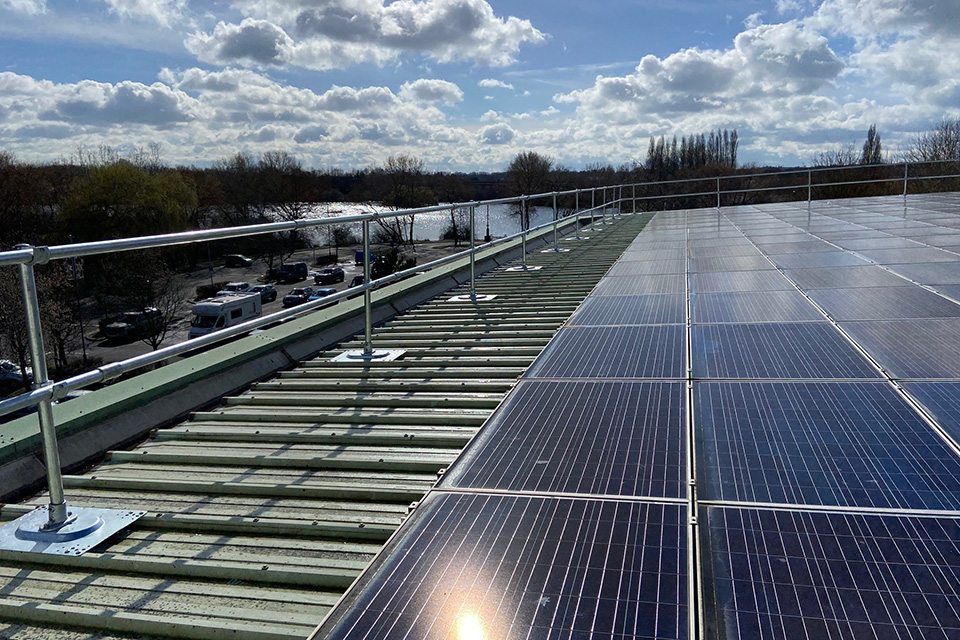How Solar Affects Your Rooftop Fall Protection Plan

Solar energy installations are on the rise.
You may want to reduce greenhouse emissions or become energy independent. Either way, deciding to install solar panels can impact more than just your energy bill.
These large installations take up a lot of space. The rooftop is often unused realty that can be perfect for such an array. This addition to your roof will affect your fall protection plan.
Whether it’s the International Fire Code or OSHA, here’s what you need to know when designing your fall protection plan.
The Code Effect of Solar in Fall Protection

There are several codes that impact when and where you need fall protection because you’ve installed solar panels.
The International Fire Code (IFC) is most commonly adopted by local municipalities when implementing codes. Make sure to double check with your local authority for anything IFC related.
In Chapter 12 of the IFC, rooftops are required to have a 6-foot clear path around the perimeter of the roof.
Just picture firefighters needing to gain access to the roof in the event of an emergency. They need space to move and work.
There is one caveat. If your building’s length or width is 250 feet or less, then the clear path’s width can be reduced to 4 feet.
These pathways need to have minimal obstructions. These could be vent pipes, conduit or mechanical equipment.
This restricts where you can place your fall protection. A guardrail or horizontal lifeline cannot be placed within this 6-foot perimeter. Proper placement of your fall protection may affect where you put your solar panels. After all, every inch counts on a rooftop when placing solar panels.
When using guardrail as fall protection for your solar panels, you need to consider how fire fighters will gain access to the roof. You are required to provide access according to the IFC. Such pathways need to be 6 feet wide, or 4 feet depending on the size of your building.
Solar panel installations would be considered mechanical equipment. Therefore, according to IFC, you need to have guardrail installed anywhere the solar installation is within 10 feet of the roof edge. The only exception is if a personal fall arrest system that complies with ANSI Z359.1 is installed.
OSHA also comes into play here. No matter what, if you are within 15 feet of the roof edge, you need to have some form of fall protection installed. If you are more than fifteen feet away, then you may not need fall protection if you meet the temporary and infrequent requirements.
It’s important to remember that these numbers are based on where the worker is and not the solar panel. Your solar panel being 15 feet and six inches from the edge does not mean the work zone is safe. If your employee is 14 feet from the roof edge to inspect or maintain it, then you need fall protection.
These are all important as you consider where to place your solar panels on your rooftop.
The Type of Solar Fall Protection You Can Use

According to OSHA, the options for rooftop fall protection are guardrails, travel restraint, fall arrest, and safety net systems.
How does installing solar affect these options?
According to OSHA’s energy safety guidelines, you should start with a guardrail. Only once you’ve determined that a guardrail is not feasible should you pivot to a personal fall protection system, like a horizontal lifeline.
The IFC would agree. It states that you need to have a guardrail where fall protection is required. It lists using a fall arrest anchorage as an exception, demonstrating the priority it has on guardrails.
It’s important to note that personal fall protection systems are compliant solutions. However, the emphasis placed on guardrail by both safety standards represents what you’ll find in the hierarchy of fall protection.
If you choose to use a personal fall protection system, then here are a few things you should know as it relates to your solar installation.
Connectors are your concern. A connector is the lanyard or rope with a rope grab that will connect a worker with the fall arrest anchor.
Connectors can get caught in the solar panel structure. This could potentially damage the connector, making the fall protection system obsolete...while the worker is using it. This would be catastrophic if a fall were to happen before this can be addressed.
Remember that there needs to be a clear path around the perimeter of your roof. So, the qualified person needs to keep this in mind when they design your fall arrest system. Not to mention that solar panels are typically installed in long rows. This will be a challenge using a personal fall arrest system to gain access to panels in the middle.
In the event of a fire, would you expect firefighters to tie off to your fall protection system? Even if they did, would it support them?
Most systems are designed for a person who is 310 pounds or less, including all of their gear. A firefighter has a lot of gear...a lot of heavy gear. Not to mention that there will likely be more than 2 on the roof, another limitation often found with using a personal fall protection system.
What about under the roof?
If you’re installing solar on an asphalt roof, then there’s a good chance you’ll need to gain access to the attic or loft. This presents another safety issue. Attic floors are typically open faced and you could fall through it. This is simple to avoid if you use a portable cover that you can set right on the 2x framing.
Win/Win for Solar Installation Fall Protection
Fall protection is needed both during installation and after installation. Often, contractors will provide their own fall protection to keep their team safe. That same fall protection often goes home with them when their done.
So, they spend time setting up the fall protection and they spend time taking it down. Who pays for that?
As the owner, you could benefit from that time by having your contractor install permanent fall protection from the beginning. This will protect the contractor and it will protect your maintenance staff as they inspect and maintain your new solar panel installation.
As the contractor, it saves you time from having to tear down your fall protection and carry with you. This will allow you to get to the next job faster. It would also be a little more revenue for you business.
It’s a win / win solution for both owner and contractor.
Wrap Up
Solar energy installations add value to your business and our earth. However, there are more things to consider than just how solar will affect your energy bill.
No matter what stage in the solar installation you’re in, contact our fall protection experts to help you discover and design the fall protection plan that will keep your people safe for years.
After all, isn’t it best to have a fall protection system that lasts as long as your solar array?



